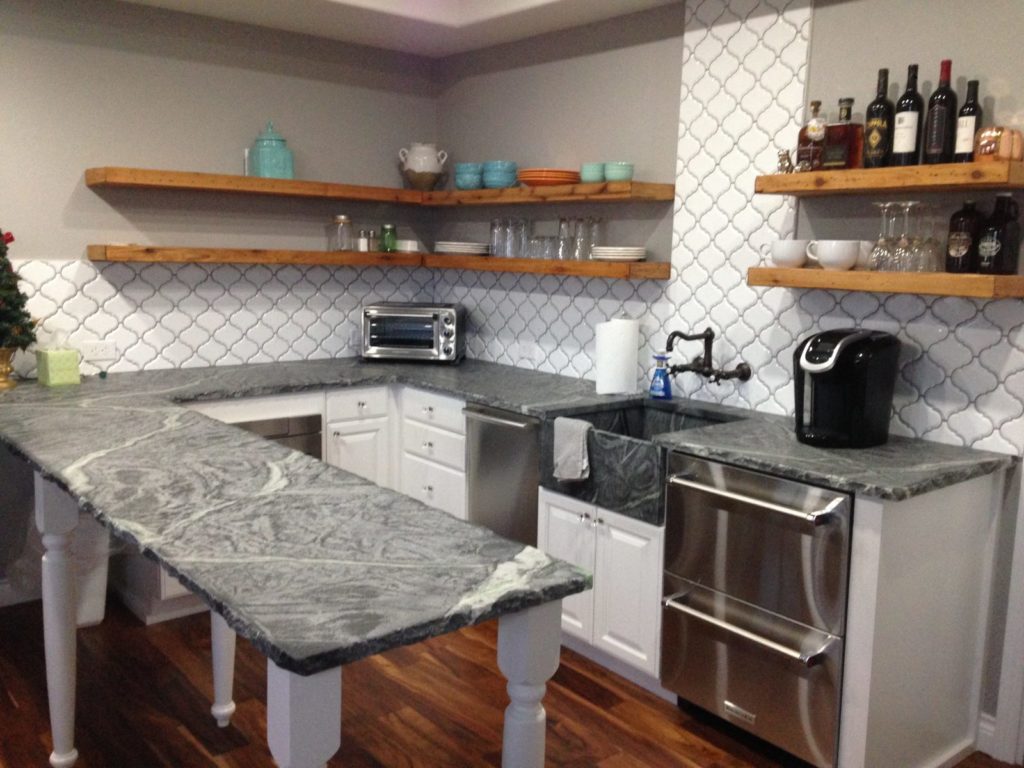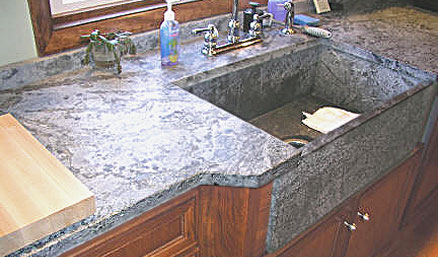
Soapstone looks naturally beautiful and therefore it is a preferred material for countertops. Soapstone, as the name suggests, feels smooth and waxy to touch, just like touching dry soap. Nevertheless, it is very durable and ideal for countertops. It is a metamorphic rock and is formed under the earth’s surface. It takes millions of years to reach its texture and durability, and has to be quarried just like any other natural stone.
Soapstone is characterized by naturally formed specks and veins that give it a varied pattern, making each soapstone countertop look unique.
Soapstone countertops have a smooth, shiny and non-porous surface; therefore they do not collect bacteria, are not absorbent and do not stain if wine or other liquids spill on them. They are also not etched by acidic liquids. Therefore they can last a lifetime without much maintenance.
Soapstone is highly heat resistant and is preferred for baking areas and fireplaces. Therefore placing hot pots directly from the stove on them will not affect them.
Soapstone can be carved into various shapes, and therefore rounded or square sinks can also be made using them. This gives uniformity and continuity to your countertop.
As far as color variety is concerned, soapstone has its limits since it is available only in various shades of gray.
Pricing of soapstone countertops

Soapstone is quarried from various parts of the world, and therefore it varies in pricing. Soapstone countertops that display color, in combination with attractive veining and flecking are on the costlier side. In addition, the company, size and thickness also determine the price.
Soapstone can be as expensive as marble and granite or can cost lesser depending on its quality and color variation. You can consider a rate that is more or less than $50 for one square foot of soapstone, which may include installation costs. Some contractors may charge you extra for installation.
If you are low on finance, soapstone tiles could be a beautiful alternative at a cheaper price. A soapstone-laminate combination would reduce your costs further. These are laminate countertops that use soapstone only in the areas of rugged use such as the cooking and washing area.
Buying tips for soapstone countertops
1. Before you choose your soapstone color and style, you must do your homework on how you can use it to complement your kitchen cabinets and color scheme.
2. Checking out some interior designing magazine can educate you about the latest trends. If you still feel unsure about the color shade and style, you can consult an interior designer.
3. Soapstone countertops are usually on the darker side and therefore they are best suited for light colored cabinets.
4. Soapstone blends well with shiny utensils, especially stainless steel. As well as with the sink, faucets and various other stainless steel appliances in the kitchen.
Installing soapstone countertops
Never attempt to install soapstone countertops on your own. The skilled hand of a professional installer is a must if you want your countertop to be well cut and leveled. A professional knows how to take the measurements and make the required templates. The slab will be cut exactly according to the templates to accommodate electrical and plumbing fixtures.
In order to attain a sturdy base, the installer may use metal rods, plywood and adhesives. If the base is strong, the countertop will not crack during installation or at a later time. Once your countertop is fitted on this base, the installer will begin to work on giving the seams and edges a quality finish, something that you will find difficult to achieve on your own.
Maintaining soapstone countertops
Although your soapstone countertop will require minimal maintenance, make sure you ask your installer for exact maintenance instructions.
Whether to seal soapstone or not, is a choice you will have to make. Some people prefer the weathered look and therefore do not seal soapstone countertops.
You can choose to coat it regularly with mineral oil in order to give depth and richness to the color. This is easy and can be done on your own.
Although soapstone is strong, it is best not to take it for granted. It can be scratched and chipped if you drag heavy pots or appliances across its surface, or hit it with heavy objects. Off course, the scratches can be removed by light sanding and reapplication of mineral oil on the surface.
Soapstone is impervious to lemon juice, vinegar and chemicals. Therefore some all-purpose cleaning liquids can be used for cleaning soapstone countertops, but avoid abrasive liquid and steel wool. Again, never take your countertop for granted and always use warm, sudsy water to clean your countertop.
I agree with you that Soapstone may look beautiful in a kitchen although I figure maintenance can be a problem, as it is a soft stone. What type of care and maintenance do you advise?